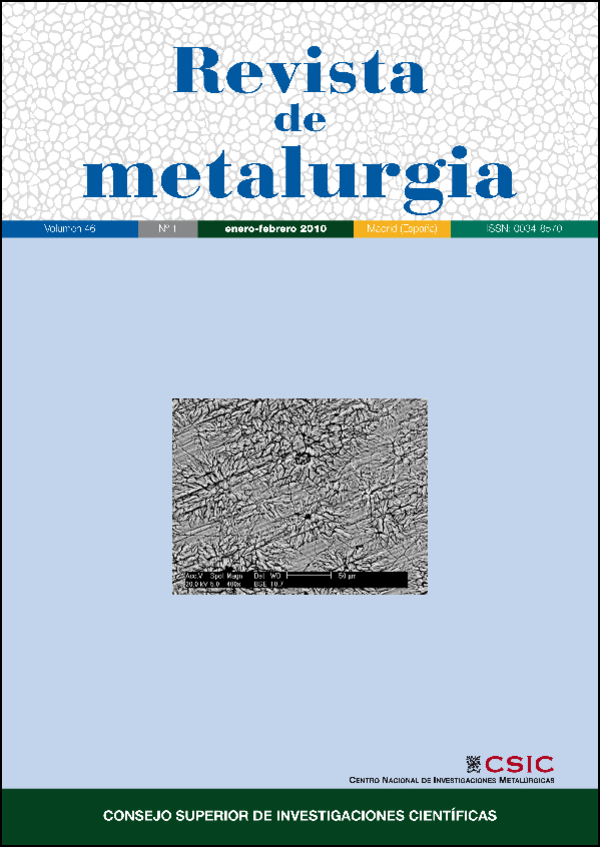Chemical conversion treatments to protect biodegradable magnesium in applications as temporary implants for bone repair
DOI:
https://doi.org/10.3989/revmetalm.0944Keywords:
Magnesium, Corrosion, Chemical conversion, BiomaterialsAbstract
The present study was developed to improve the corrosion resistance of pure magnesium by applying chemical conversion coatings. Carbonate and fluoride layers were generated by immersion in solutions of NaHCO3 of concentration 9 wt.%and HF of concentration 48 wt.%, respectively. Corrosion resistance of the coated samples was evaluated in comparison with that of the uncoated substrate by electrochemical techniques in a physiological solution (PBS). Results have shown that the carbonate coating is not viable to be used for protecting magnesium against corrosion.On the contrary, the fluoridemagnesiumcoating significantly increases the corrosion resistance ofmagnesium in physiological medium. The high compactness and adherence to the base metal of theMgF2 layer produced by this simple chemical conversion treatment confer the protective properties to the coating.
Downloads
References
[1] Y.W. Song, D.Y. Shan y E.H. Han,Mater. Lett. 62 (2008) 3.276-3.279.
[2] Y. Al-Abdullat, S. Tsutsumi, N. Nakajima, M. Ohta, H. Kuwahara y K. Ikeuchi,Mater. Trans. 42 (2001) 1.777-1.780.
[3] L. Li, J. Gao e Y. Wang, Surf. Coat. Tech. 185 (2004) 92-102. doi:10.1016/j.surfcoat.2004.01.004
[4] K.Y. Chiu, M.H. Wong, F.T. Cheng y H.C. Man, Surf. Coat. Tech. 202 (2007) 590-598. doi:10.1016/j.surfcoat.2007.06.035
[5] L. Jianrui, G. Yina y H. Weidong, Surf. Coat. Tech. 201 (2006) 1.536-1.541.
[6] M.F.Montemor yM.G.S. Ferreira, Electrochim. Acta 52 (2007) 7.486-7.495.
[7] W. Zhou, D. Shan, E. Han yW. Ke, Surf. Coat. Tech. 50 (2008) 329-337.
[8] R. Supplit, T. Koch y U. Schubert, Corros. Sci. 49 (2007) 3.015-3.032.
[9] Y.L. Cheng, H.I. Wu, Z. Chen, H. Wang, Z. Zhang e Y. Wu, Trans. Nonferrous Met. Soc. China 17 (2007) 502-508. doi:10.1016/S1003-6326(07)60123-X
[10] A. Froats, T. K. Aune, D. Hawke,W. Unsworth y J. Hillis,Metals Handbook, Vol. 13, ASMIntl, 9th edition, Ohio, EE. UU., 1987, pp. 740-754.
[11] A. Drynda, T. Hassel, R. Hoehn, A. Perz, F.W. Bach y M. Peuster, J. Biome. Mater. Res. A. (2009) editado “On line” (03.08.2009).
[12] M. Staiger, A. Pietak, J. Huadmai y G. Dias, Biomaterials 27 (2006) 1.728-1.734.
[13] S.F. Lamolle, M. Monjo, M. Rubert, H.J. Haugen, S.P. Lyngstadaas y J.E. Ellingsen, Biomaterials 30 (2009) 736-742. doi:10.1016/j.biomaterials.2008.10.052 PMid:19022499
[14] L. Xu, G. Yu, E. Zhang, F. Pan y K. Yang, J. Biomed. Mater. Res. 83 A (2007) 703-711.
[15] N. Pebere, C. Riera y F. Dabosi, Electrochim. Acta 35 (1990) 555-561. doi:10.1016/0013-4686(90)87043-2
Downloads
Published
How to Cite
Issue
Section
License
Copyright (c) 2010 Consejo Superior de Investigaciones Científicas (CSIC)

This work is licensed under a Creative Commons Attribution 4.0 International License.
© CSIC. Manuscripts published in both the printed and online versions of this Journal are the property of Consejo Superior de Investigaciones Científicas, and quoting this source is a requirement for any partial or full reproduction.
All contents of this electronic edition, except where otherwise noted, are distributed under a “Creative Commons Attribution 4.0 International” (CC BY 4.0) License. You may read the basic information and the legal text of the license. The indication of the CC BY 4.0 License must be expressly stated in this way when necessary.
Self-archiving in repositories, personal webpages or similar, of any version other than the published by the Editor, is not allowed.
















